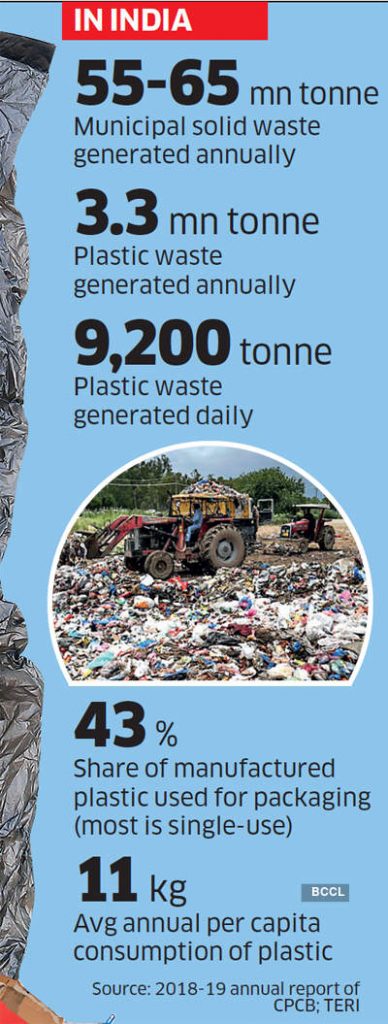Context:
A detailed report published Minderoo, a nonprofit organization sheds new light on throwaway single-use plastic producers and the threats they pose as one of the world’s biggest environmental hazards.
Relevance:
GS-III: Environment and Ecology (Pollution Control and Waste Management, Environmental Degradation)
Dimensions of the Article:
- What are Single-Use Plastics?
- Highlights of the report on Production of Single-use plastics
- Steps taken to confront the Single-use plastic threat
What are Single-Use Plastics?
- Single-use plastics, or disposable plastics, are used only once before they are thrown away or recycled – example: plastic bags, straws, coffee stirrers, soda and water bottles and most food packaging.
- Instruments such as syringes, applicators, drug tests, bandages and wraps are often made to be disposable – and these are applications of single-use plastic that can’t be avoided easily. Single-use plastics also help in keeping food and water fresher for longer and reducing the potential for contamination – hence, they have been enlisted in the fight against food waste.
How is it a problem?
- Plastic is a huge problem as it is so cheap and convenient that it has replaced all other materials from the packaging industry leading to production at unprecedented levels – but it takes hundreds of years to disintegrate.
- Petroleum-based plastic is not biodegradable and usually goes into a landfill where it is buried or it gets into the water and finds its way into the ocean. In the process of breaking down, it releases toxic chemicals (additives that were used to shape and harden the plastic) which make their way into our food and water supply.
- Out of almost 10 million tonnes of plastic waste generated every year in India – 43% is single use plastic.

Highlights of the report on Production of Single-use plastics
- Half of the world’s single-use plastic is made by 20 big companies and their production is financed by financial services companies including banks.
- Governments are also big stakeholders in this industry, as about 40% of the largest single-use plastic makers are partly owned by governments, including China and Saudi Arabia.
- Single-use plastic has been a very good business, and that’s projected to continue. In the next five years alone, production capacity is forecast to grow by 30%.
- An average American uses and throws away 50 kilograms of single-use plastic every year whereas an average Indian uses less than one-twelfth of an American. – hence, there is a huge disparity between richer and poorer nations.
- It is far cheaper to make things out of newly produced plastic than from recycled plastic – hence a very small percentage gets recycled (about 8% of plastic gets recycled in the US).
- State and municipal governments have had success in banning certain items like plastic grocery bags, foam cups and drinking straws. But the efforts focused on curtailing the production of single-use plastic have been limited so far. Advocacy efforts to persuade consumers to use less plastic have failed to gain traction.
Steps taken to confront the Single-use plastic threat
- European Union issued a directive calling for consumer brands to use at least 30% recycled content in plastic bottles by 2025.
- In 2019, the Union government in a bid to free India of single-use plastics by 2022, had laid out a multi-ministerial plan to discourage the use of single-use plastics across the country.
- Plastic Waste Management Rules, 2016 which extended the responsibility to collect waste generated from the products to their producers and brand owners.
-Source: Hindustan Times, Indian Express




